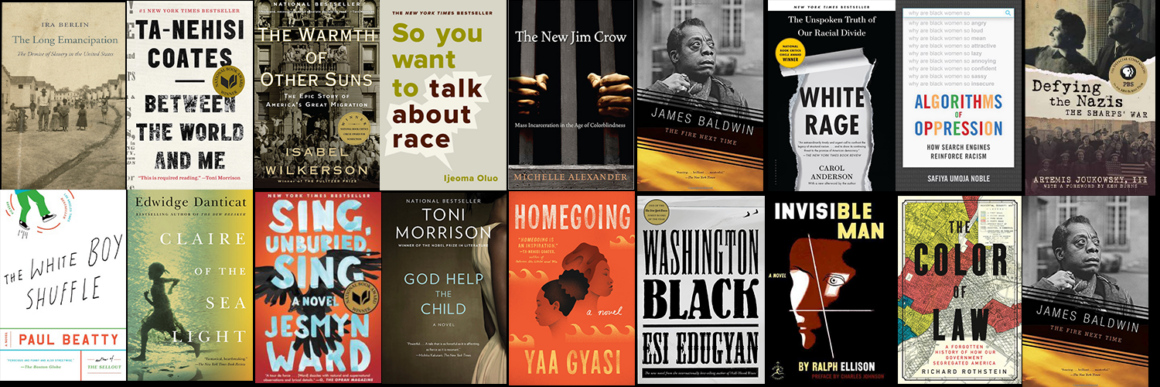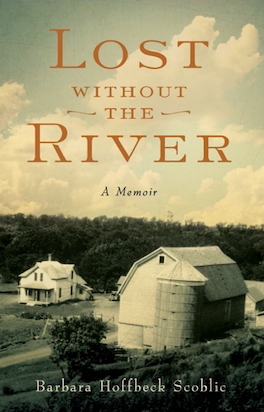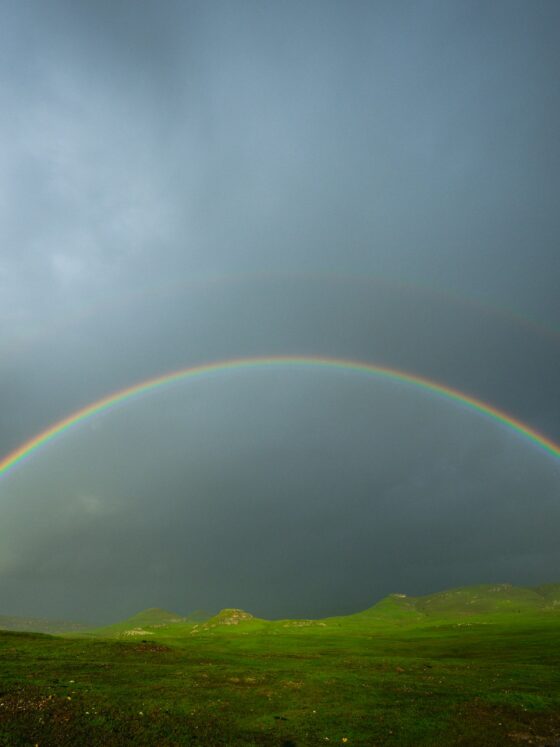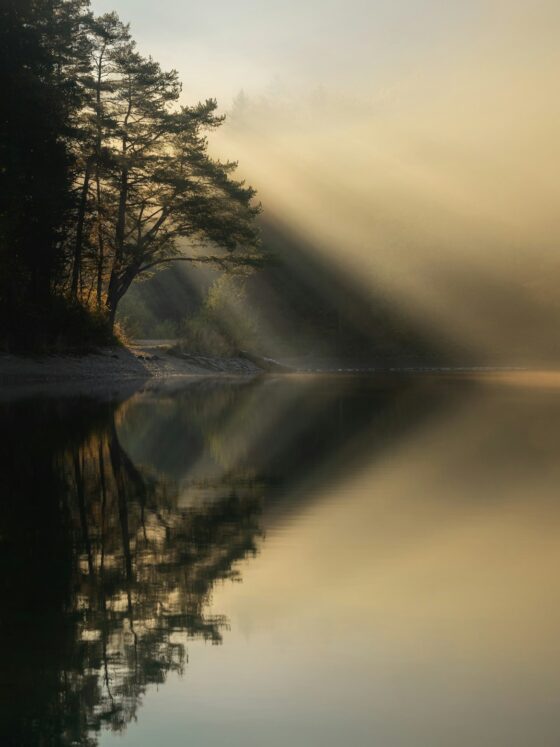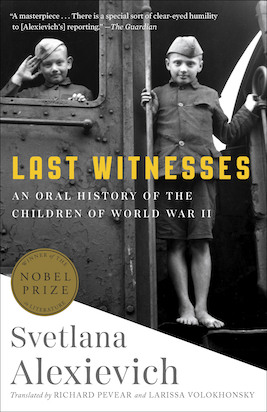Lost Without the River: A Memoir by Barbara Hoffbeck Scoblic. Published by She Writes Press.
Barbara Hoffbeck grew up during the Great Depression on a small dairy farm outside Big Stone City in northeastern South Dakota. South Dakota was not officially in the Dust Bowl, which was centered on the Oklahoma panhandle; nevertheless, in those years, South Dakota suffered the Great Drought, also called the Dirty Thirties. It was tough times for farming communities.
Built in 1873, the house where Barbara grew up was “probably the first wood-framed house in the area.” Her paternal grandfather, Bertel Hoffbeck, a Danish immigrant, bought the farm in 1913 so that his eldest son Roy, Barbara’s father, could walk to school.
Barbara’s parents, Roy and Myrtle, met while they were students at South Dakota State College (now known as South Dakota State University). In 1926, after they were married, they moved into that wood-framed house. Roy and Myrtle’s first child, Dorothy, was born in 1927, and their seventh and last child, Barbara, was born in 1939, making Barbara the youngest of four daughters and three sons.
The farm was a diversified working farm with a barn (for the cows), a horse barn, a hog house, and a chicken coop. It also had a granary, a corn crib, a garage, an outhouse (i.e., they had no indoor plumbing), a silo for fermenting corn and other grasses into silage and storing it to feed to the cows, and an outdoor, underground cellar for storing root vegetables and providing shelter during a tornado.
***
Growing up, Barbara and her siblings knew that they were living on land previously occupied by bands of the Great Dakota Nation. Tangible evidence of those Native Americans were artifacts — for example, a rock war club and arrowheads — that they found on the farm.
Everyone worked hard on the farm: Dad, Mom, and, when they were old enough, Barbara and her brothers and sisters. They worked long days, with the men generally working outdoors and the women working indoors until they were older. Barbara, the youngest child, worked alongside her mother in the house after her sisters were old enough to work outdoors.
About the work — chores, chores, chores, “day after day” — Barbara wrote, “Almost always what we were told to do was hard work and boring. Complaining wasn’t an option. Whom would we complain to? Our mother? We could see that she never stopped working. Our father? Absolutely not. He didn’t tolerate laziness or excuses.” A handful of chocolate chips sometimes was the reward for a job well done. For Barbara’s father, his reward for a day’s work was turning “on the radio at ten o’clock each evening to hear the news.”
They worked in the garden, which covered a quarter acre (about 11,000 square feet), in the fields, and in the surrounding wild areas. In the river, they caught fish and turtles; and in the woods and fields, they picked apples, wild berries, wild plums, and wild asparagus. Some of this food was eaten freshly picked, but much of it was either preserved by pickling, fermenting, or canning or by storing it in the root cellar. Except for staples such as sugar and salt, the family was self-sufficient with food. The kids also trapped animals and sold sweet corn and other garden crops, packets of Burpee seeds, and bait minnows, which they sold door-to-door in Big Stone City.
They milked their small herd of Holstein cows twice a day, drank some of the milk, sold some of the milk, made butter from the cream, and sold it too to bring meager income into the family. They also ground some of their wheat harvest to make their own flour.
On a rare ride into town with her father to get groceries, Barbara and her dad would stop at a café for a coffee for dad and a cookie for Barbara.
***
To be successful, farmers must prepare the fields, plant seed, and harvest the crops in that order and at the right time. Farmers depend on the weather to deliver timely rain and then, when it’s harvest time, to provide sunshine and wind to dry the corn, wheat, and other crops.
A legendary dust storm on May 8, 1934, a result of drought and wind, upended farmers’ work for that year. The storm was before Barbara was born, but she heard about it growing up because it had become a part of family lore. Nineteen thirty-four was also the year Barbara’s father began working for the Works Progress Administration (WPA) to supplement the meager income from the farm during the Great Depression and Great Drought. Two years later, in 1936 — a year of extreme temperatures in South Dakota (a high of 120° F and a low of -58° F) — a plague of grasshoppers ate the crops and even the laundry. Barbara wrote, “When at last rain began to fall again [in 1939, the same year in which Barbara was born], my father was never able to catch up financially.”
***
A small branch of the Whetstone River meandered through the farm, taking two bends near the house. The eponymous river gave the family a place to cool off after work on a hot day, as well as fish to eat. A local man collected clam shells from the river, cleaned them, and hauled them to town to be loaded onto trains that took them to Minnesota and Iowa to be made into buttons. Barbara imagined that some of the buttons ended up in Chicago and New York City, where folks in fine clothes and dining at fine restaurants wore those buttons.
Big Rock, a landmark granite outcropping, sat at the river bend near the house. Sites along the river were described as being either upstream or downstream from Big Rock. It also was a place to fish from and a place to which Barbara retreated when she sought solitude and solace. Later in life, when she visited the farm, she would return to Big Rock again and again.
In some years, the river overran its banks when early spring ice jams blocked the flow of water downstream and onto the farm. Then the family scrambled to sandbag their home.
***
The family was self-sufficient for much of the year, but they knew that help was not far away when they needed it. One such time was harvesting grains such as oats, which required a large machine that a single farmer could not afford. Such machines were owned and operated by mobile “custom” operators who moved from farm to farm. Neighbors helped neighbors during harvest season, working with the custom operator and other farmers to bring in the crop. Farmers’ wives fed these crews three times a day: mid-morning and mid-afternoon lunches and a full meal at noon. The wives each fed their own husband’s breakfast and the evening meal.
Big Stone City was not a big town (population 357 and 681 in 1930 and 1940, respectively), but to Barbara’s great-uncles Hank and Bill, who lived in Montana, Big Stone City was an “oasis of civilization.” Monthly social meetings at the Farmers’ Club gave the community a chance to get together, dance, see performances of original plays, and participate in group singing. Barbara’s father was the chairman of the local school board and handed Barbara her diploma when she graduated (as valedictorian, no less).
***
Like so many young men and women of their generation, all but one of the Hoffbeck children left home after they graduated from high school. The titles of two chapters near the middle of the book sum it up nicely: “One By One” and “Packing Up.” Helen, the second eldest, was the first to leave, for business school in Minneapolis. “My parents,” Barbara wrote, “became accustomed to saying goodbye … None of Roy and Myrtle’s children remained in South Dakota. All of us moved to other states to pursue our careers.”
After Barbara graduated from college, she responded to President John. F. Kennedy’s call in his inauguration address in 1961, “Ask not what your country can do for you — ask what you can do for your country.” Later that year, Kennedy established the Peace Corps. Barbara was “in one of the first groups of Peace Corps volunteers in Thailand, stationed alone in a small town …,” where she served until 1965. She later settled in New York City and worked in the publishing industry.
Barbara and her siblings may have left home, but they continued to cultivate their rural roots by returning to the home place and maintaining their connection in their own ways. Bob became an agronomist and corn breeder and advised farmers. Bill grew a big garden and experimented with new varieties of vegetables. Helen grew vegetables and fruit in her gardens. Patt bought a small farm and rented out the land to farmers.
When Barbara returned home from the Peace Corps, she “felt the constrictions of small-town life with a new awareness. I couldn’t imagine staying, living under ever-vigilant eyes.” And yet, she wrote on the last page of her memoir, “When I’m dying — if I’m given half an hour’s notice — I’ll drive that bumpy old road one more time. … There it will be, the way it once was! The cottonwood green and healthy; the barn tall and strong; and the house white — oh, yes, white again! And, of course, the river beyond.”
***
In the book, the author has included a sketched map of the farm; a family tree; photographs of the river, from a shallow stream only 3 feet wide with steppingstones across it, to a deeper section more than 20 feet wide; and family photographs — one of Barbara gleefully holding a large cucumber with one brother and two other brothers holding long guns; and another with Barbara sitting on Big Rock in 1989.
I know a bit about the life that Barbara experienced. My parents and all my aunts and uncles grew up on such farms in Minnesota during The Great Depression, without indoor plumbing (which didn’t arrive until the 1950s), a few farm animals, diversified crops, vegetable gardens, and the hard work that goes with all of that. Most of my cousins and I also lived without indoor plumbing when we were very young. And like Barbara and her siblings, some of us left rural life and moved into larger towns or cities in Minnesota or, as I did, to Iowa with my family in 1952, and then to California, Ohio, and finally to Lancaster, Pennsylvania. My dearest memories of my youth in Iowa are of roaming the land with my brother and finding arrowheads and geodes, finding fossils in the crushed limestone on the gravel roads, trapping pocket gophers for bounty, and fishing.
